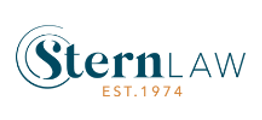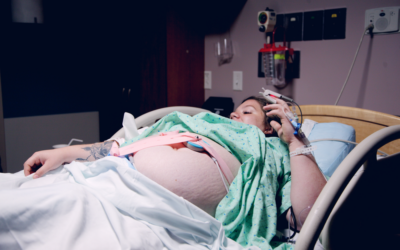Birth Injury Claims: Obstetric Emergencies
Stern Law is led by Principal Solicitor, Terry Stern, one of the most experienced medical negligence lawyers in NSW with over 35 years’ experience in the field and an Accredited Specialist in Personal injury Law.
Our Commitment: Stern Law is dedicated to a team approach, drawing on a variety of skills and backgrounds in medical negligence law to get our clients the best results.
Obstetric emergencies are extremely serious and life threatening to both the mother and baby. It is expected that Obstetricians and Midwives respond to these situations in a competent, appropriate and timely manner. Failure to do so can result in a potential claim for medical malpractice, where it can be determined that the clinician did not meet the standard of care required.
At Stern Law, we hold a strong interest in birth injury claims, believing that women deserve the right to compensation, following childbirth trauma.
Examples of Obstetric Emergencies

Uterine Rupture
Although a very rare complication, uterine rupture is a maternal- fetal emergency in with the uterus tears, putting the lives of both mother and baby at risk.
When the uterus ruptures, the baby can be deprived of oxygen (birth asphyxia) and develop a serious brain injury called hypoxic-ischemic encephalopathy which can cause ongoing seizures, cerebral palsy, and other intellectual impairments. This complication also increases the risk of significant maternal haemorrhaging resulting in life threatening blood loss. The severity of these complications will depend on the length of time it takes the Obstetrician to diagnose the condition and expedite birth.
Risk factors for uterine rupture include:
- Vaginal birth after Caesarean Section (VBAC)
- Grand multiparity (birthed more than 5 children)
- Excess amniotic fluid e.g., polyhydramnios
- Multiple births e.g., twins
For women attempting a vaginal birth following caesarean section (VBAC), it is crucial they provide ‘informed consent’, meaning that an obstetrician has explained the material risks including uterine rupture at the site of the caesarean scar. VBAC should only be attended in facilities which are equipped for continuous fetal monitoring, emergency caesarean section and neonatal resuscitation.
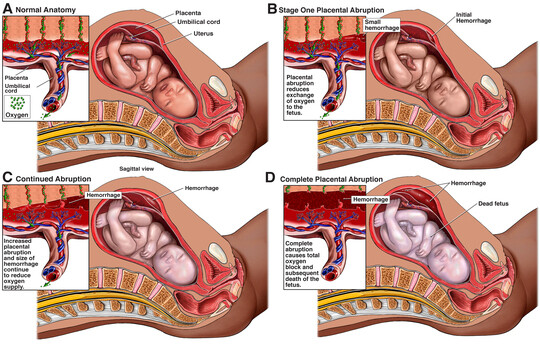
Placental Abruption
A placental abruption occurs when the placenta separates prematurely from the uterus wall which places both the mother and baby in imminent risk. This is a medical emergency which requires immediate obstetric attention.
When the placenta detaches, the baby can experience ‘birth asphyxia’ which can create complication including HIE and cerebral palsy.
Risk factors include:
- Multiple births
- High blood pressure
- Previous abruption
- Smoking
- Maternal age > 40 years
The obstetrician is required to meet the standard of care to both identify and treat this complication, often by emergency caesarean section, in a timely manner. Failure to do this and harm occurs in result, can establish grounds for medical negligence.
Cord Prolapse
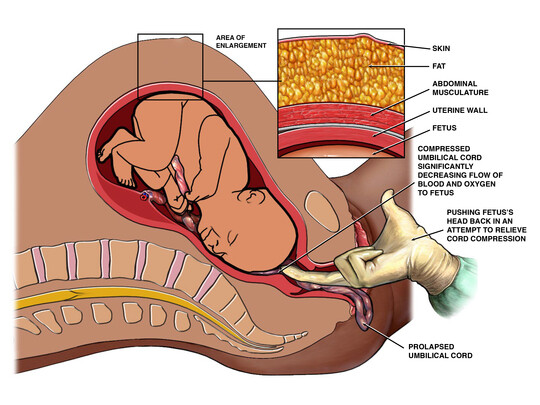
Cord prolapse is a rare neonatal emergency which occurs in 0.2-0.4%[1] of births when the umbilical cord lies ahead of the presenting part of the fetus and moves into the cervical canal, vagina, or comes out of the birth canal. When cord prolapse is identified, birth should be expedited immediately as oxygen and blood flow to the baby is severely compromised.
Caesarean section is the primary mode of delivery, however if vaginal birth is imminent this can be attempted also. The obstetrician or midwife should elevate the presenting part to reduce the impact of cord compression until the time of birth. (see image right)
If the baby is not delivered immediately, this can lead to severe consequences including; neonatal hypoxia (low levels of oxygen), HIE or neonatal death.
Appropriate management of obstetric emergencies
- Recognise, diagnose, and respond in a timely manner which aligns with the standard of care.
Many of these complications can be avoided by close fetal monitoring through:
- Regular ultrasounds for women with risk factors
- Routine CTG (Fetal Heart Rate monitoring)
Placental Abruption
A placental abruption occurs when the placenta separates prematurely from the uterus wall which places both the mother and baby in imminent risk. This is a medical emergency which requires immediate obstetric attention.
When the placenta detaches, the baby can experience ‘birth asphyxia’ which can create complication including HIE and cerebral palsy.
Risk factors include:
- Multiple births
- High blood pressure
- Previous abruption
- Smoking
- Maternal age > 40 years
The obstetrician is required to meet the standard of care to both identify and treat this complication, often by emergency caesarean section, in a timely manner. Failure to do this and harm occurs in result, can establish grounds for medical negligence.
Cord Prolapse

Cord prolapse is a rare neonatal emergency which occurs in 0.2-0.4%[1] of births when the umbilical cord lies ahead of the presenting part of the fetus and moves into the cervical canal, vagina, or comes out of the birth canal. When cord prolapse is identified, birth should be expedited immediately as oxygen and blood flow to the baby is severely compromised.
Caesarean section is the primary mode of delivery, however if vaginal birth is imminent this can be attempted also. The obstetrician or midwife should elevate the presenting part to reduce the impact of cord compression until the time of birth. (see image right)
If the baby is not delivered immediately, this can lead to severe consequences including; neonatal hypoxia (low levels of oxygen), HIE or neonatal death.
Appropriate management of obstetric emergencies
- Recognise, diagnose, and respond in a timely manner which aligns with the standard of care.
Many of these complications can be avoided by close fetal monitoring through:
- Regular ultrasounds for women with risk factors
- Routine CTG (Fetal Heart Rate monitoring)
- Complete history of previous births
- Monitoring vitals and completing appropriate investigations e.g., blood tests
For many obstetric emergencies, the ability to facilitate an emergency caesarean section is crucial in reducing the likelihood of poor outcomes. However, often if appropriate antenatal care had been provided, these situations could likely have been avoided.
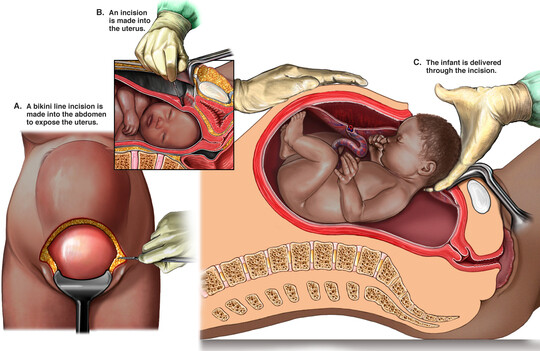
For hospitals with staff specialists on call, it is important for them to have established emergency procedures and an on- call chain on command to efficiently respond to these life-threatening emergencies, especially as they often occur overnight.
If you believe your care was mishandled, the clinicians did not listen to your concerns or did not meet the standard of care required by professionals in this situation, it is likely to establish grounds for a medical negligence claim.
To commence a claim for birth injury, it is necessary to establish that the healthcare provider did not meet the standard of care required by that professional. This can be proven by demonstrating that; the practitioner owed a duty of care, which was breached and in consequence caused harm to you or your baby.
How Stern Law can help you.
The nature of these claims is complex and requires solicitors who are specialised in medical negligence law. With your consent, we will request your personal medical records, which will be reviewed by specialist medical negligence solicitors and expert medical advice to determine whether you have grounds for a claim.
For an empathetic and compassionate approach to compensation, reach out to our team of experts in medical negligence at Stern law.
Please call us on (02) 9387 1399 or email us at re*******@**********om.au
We look forward to sharing this journey with you.
Disclaimer: The content of this article is intended only to provide a summary and general overview of matters of interest. It does not constitute medical or legal advice and should not be relied on as such.
Photo references:
Nmal. Nucleus
[1] St John ‘Cord Prolpse’ (2017) Cord Prolapse (stjohnwa.com.au)

